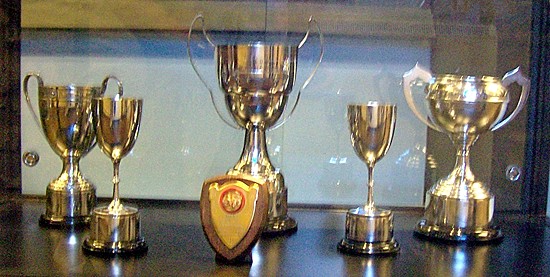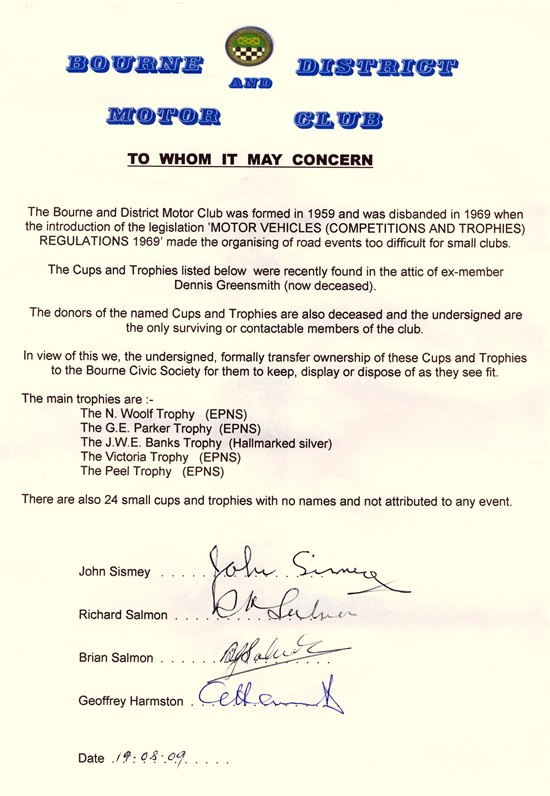|
Bourne and District
Motor Club

In 1959, a group of people
interested in motor sports decided to form the Bourne Motor Club to promote
different forms of motoring activities. This was the time when treasure
hunts and local rallies around the area were very popu1ar.
Treasure hunts were being organized by many groups and Sunday afternoons
and the lighter evenings would see 15 to 20 cars chasing round the
countryside looking for hidden clues to take them on to the next part of
the route and, hopefu11y, get to the finish first. Although there was not
much traffic on the roads, it was becoming a nuisance when a horde of
people descended on a village looking for a bit of paper.
Rallies were similar in that they took place on the roads but this time
you were not looking for clues on the way. You were given a set at the start and you had to work out on the map the shortest route to pass
through a series of points while maintaining a particular average speed.
There wou1d be undisclosed marshals on the route to record your arrival
time at each check point so that your average speed could be recorded. To
be able to complete the course, each car needed a driver, a navigator to
keep you on the route which usually lay over minor and unsurfaced roads,
and a timekeeper to repeatedly work out your average speed from time
and distance travelled. If you took the wrong route and had to back-track,
as happened quite often, the timekeeper wou1d have to do a quick
recalcu1ation after deducting the extra mileage.
By 1969 there was a lot of ill-feeling growing throughout the country
about people chasing around the countryside on Sunday afternoons and
summer evenings. Eventually, the government of the day brought in the
legislation under the Motor Vehicles (Competitions and Trophies)
Regulations 1969 which required organisers of rallies and treasure hunts
to submit details of the route to the appropriate chief constable a month
ahead and to get permission to hold the event and there were quite often
objections about safety and nuisance which caused extra problems for the
organisers.
These requirements became too complicated for most organisations and
rallies and treasure hunts were killed stone dead over night, except for a
few larger regional ones like the East Midlands Vintage Car Rally who were
prepared to work the system. There was also great interest in autocross
which involved an ordinary road car, and later on some specials, driving
round a track in a grass field. The cars wou1d usually go in pairs to
avoid collision and damage to their vehicles and the time to complete a
specified number of laps wou1d be recorded.
There wou1d be different vehicle groups and some form of handicapping,
depending on engine size, so that everyone had an equal chance of
finishing first. The fastest overall driver after applying the
appropriate handicap would get a trophy which was competed for annually.
There would also be a group for specials which were either modified
production cars or were built from the wheels up, probably using an
enhanced production engine and minimum bodywork. More people were building
specials and these evolved into banger racing which was getting closer to
stock car racing on grass and the Bourne Motor Club decided it could not
get involved in this form of sport as the expense was
prohibitive.
As standard road cars became more expensive, their owners were reluctant
to risk getting them damaged so in the late 1960s, the sport went into
decline. Another activity was the hill trial in which
ordinary road cars went round a twisting track one at a time on a sloping
or undulating field, usually at far less than walking pace and often
hardly moving as they negotiated tricky bends between markers which had
only inches to spare. Few managed to complete the course with no faults
but there was never any damage to the cars which sometimes had to be
manhandled off the course when they got knotted up. The objective was to
get as far round the track as possible without touching the marker poles.
Time was not important but you had to keep moving and the organisers used
adverse
camber, sharp, but not dangerous, bends at precarious angles and awkward
turns in shallow
depressions to try to fool you.
Sometimes the club would organize a sprint trial on disused airfields. One
car at a time had to travel over a length of runway, usually straight or
perhaps with just a very gentle chicane, as fast as they could. Again, as
automobile repairs became more costly, the cars got more expensive to repair, this sport went into decline. A
slide or roll at these high speeds could cause expensive damage and
the insurance usually did not cover it.
By the late 1960s, the original founders of the club were gradually
replaced by some less dedicated members who thought they could do it
better but were not prepared to put in the effort to make the events run
smoothly and successfully. There is a lot going on behind the scenes to
put on an event, not least in meeting the requirements of the new rally
regulations, and the club closed down through lack of support for events
which were by now, to say the least, badly organised and chaotic.
As many of the founder members were connected to the design, development
and racing of the BRM F1 racing car there was considerable enthusiasm for
all forms of motor sport and it was a sad day when the club was closed.
|
THE END OF THE CLUB
In August 2009, the remaining officials agreed
to hand over the trophies to the Heritage Centre at Bourne for safe
keeping and permanent display. |
|
 |

Go to:
Main Index Villages
Index
|

